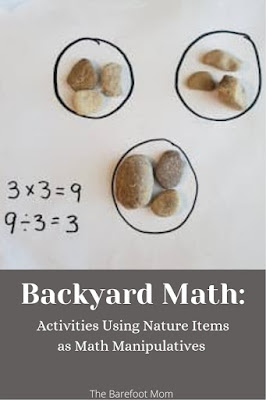In my experience kids often are more willing to practice academic skills when they can do it outside, interacting with nature at the same time. You can turn math practice into an outdoor multisensory experience by using nature items as math manipulatives. Here are some fun, hands on math activities that can be done while out exploring in nature.
Counting
Collect some small nature items like pebbles, acorns, or leaves and help your kids count how many of each there are. You can even lay them out on paper and give them space to write their totals.
Sorting
Send your kids on a hunt in the backyard or around your neighborhood to collect small nature items like pebbles, acorns, small pinecones, shells, and leaves. Then have your kids sort them by type of item and count up the total of each.
You can even add some plant science into this activity by hunting for various types of leaves or pinecones. When your done collecting, sort them by variety, and try to identify what type of tree or plant they came from.
Patterns
Collect some nature items and then arrange them in a pattern. See if your children can copy the pattern, then challenge them to create patterns of their own. Patterns can be made with items like pebbles, shells, acorns, small pinecones, and leaves. Different types of leaves could be used to make patterns based on leaf shape, or in fall you could collect different colored leaves and arrange them in a pattern based on color.
Addition and Subtraction
Pebbles and acorns make great manipulatives for practicing basic addition and subtraction problems. Grab a handful of pebbles and set up problems for your kids to solve.

Multiplication and Division
Small nature items like pebbles and acorns also make great manipulatives for multiplication and division practice. Grab some sidewalk chalk and draw several circles on the driveway. Practice multiplication facts by having your kids figure out the total if you place a specific number of pebbles in each circle. For example if your draw 5 circles and place 5 pebbles in each circle, how many pebbles is there in total?
For division, do the opposite process. Start with a total number of pebbles and have your child figure out how many each circle gets if you divide them evenly. If you start with 9 pebbles and have 3 circles, how many pebbles does each circle get?
Graphing
Send your kids outside and challenge them to collect some nature items. Have them sort them by type and count up the total for each type. Use the data to make a bar or pie graph.
Measuring
Have your kids collect some sticks or large pinecones. Then pull out a tape measure or ruler and have them measure and record their lengths. Have your child identify which object was longest and which was shortest.
The same activity can be done with rocks and a scale to measure weight.
Base 10
Sticks are awesome manipulatives for base 10 activities. Collect some small sticks of similar lengths. Have your kids help you count out groups of 10 and rubber band them together. These will be your 10's place values. Leave 9 sticks single for your one's place values.
Give your child a 2 digit number, like 13, and have them represent it with sticks using your 10's bundles and singles. Or set up some 10's bundles and singles and have your child figure out how many sticks.
Doubling
You can practice doubling numbers with nature items by setting out a hand full of pebbles, shells, or acorns. Count out a specific number, like 3, and then ask your child to double that number. Or set up a doubles chart like the one below. Fill in the left hand side of the chart with nature items and then have your child fill in the right side.
What are some of your favorite hands on math activities?
If you enjoyed this post, check out:
Follow me on:










I love this set of ideas so much! I added a link to your blog in my blog post that focuses on using leaves, sticks, and acorn tops to develop pre-math skills for preschoolers.
ReplyDeleteHere's a link to my blog: http://steamma.blogspot.com/2019/02/leaves-sticks-and-acorn-tops.html?m=1
I also added it to another post about doing math with shells. And I shared your Facebook post to my Facebook page. Thank you for sharing your great ideas!